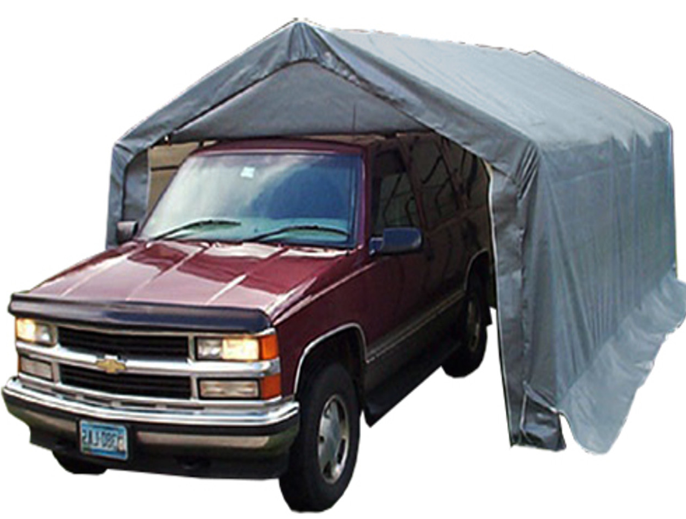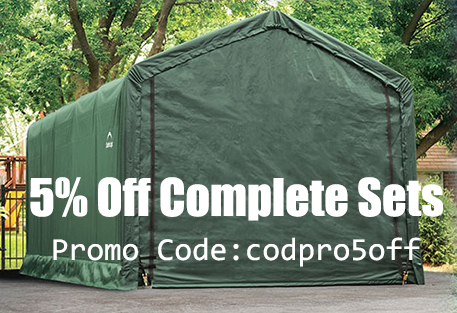How to Build Your Own Carport
May 24th 2022
Building a traditional garage to protect your car, or that new RV or boat, makes sense until you consider the price tag.

A quick online search shows the average cost for a single-car garage ranges from $24,000 and upwards - not including the additional costs of wiring and building permits.
The solution? A DIY carport. Using a tarp and other inexpensive materials, you can quickly, easily create your own DIY car canopy for your car, truck or RV for a fraction of the cost of a permanent brick or wood structure. Build your homemade carport from scratch, or consider an economical carport kit with carport frame from Canopies and Tarps.
If you already have a traditional garage, a DIY carport is your lowest-cost solution when you bring home that second vehicle. A DIY carport is also a budget best bet for that weekend vacation home.
Customers also tell us they use their DIY carports for occasional outside entertaining under the shelter of their roof. Many set up shelves inside their build-your-own carport to store tools and lawn equipment. Or, they build a DIY carport with enough space for a small workshop table with shelves inside.
A tarp carport can keep your vehicle's paint job from dulling while also protecting it from rain and rust. It will also deflect debris.
Intrigued? Read on to learn how to build your own carport.
DIY Carport Parts
First, measure the space you want for your DIY carport. After you have written down the exact measurements, it's time to assemble your materials.
You will need an appropriately sized tarp for a cover. For protecting vehicles or machines, a blue tarp is a good choice to help block the sun's ultraviolet rays. At Canopies and Tarps, you'll find dozens of colors and styles at bargain prices.
It's best to pick a high-quality tarp that is UV-resistant, weatherproof, waterproof and rot-proof. That will ensure superior protection for what's under it, as well as provide the longest life for your structure's covering.

Lightweight PVC pipes, along with T-connectors and 45-degree angle connectors, will be necessary for the frame. If you are erecting your carport on paved or hard ground, you'll need to keep the structure solidly anchored by filling 5-gallon buckets with concrete. Insert a pipe into one at each corner of the carport. For carports more than 8 ft. long or 10 ft. wide, add an extra pair of buckets every 6 ft. or so.
With the vertical pipes standing perpendicular, attach a T-connector to the top of each pipe. At one end of the T, add a vertical pipe and an angled connector. At the other end attach a horizontal pipe. Place an angled connector at the other end of the horizontal pipe and join it to another vertical pipe. Repeat this process with your remaining pipes.
Take two 8-ft. pipes with a cross connector at each vertical pipe. Then, insert them into an angle connector on the vertical pairs. Do this with your remaining pipes to complete the frame of your carport.
Next, place the tarp over the frame. You can keep the tarp stationary by tying it with ropes, using bungee cords or clamps. Make sure the connections are tight and strong to secure the tarp, even on windy days. Find the right carport tarp accessories at lower prices at Canopies and Tarps.
Carport Kits
If you want to cut your DIY time in half or more, consider a carport kit. An inexpensive 10-ft. by 10-ft. tarp carport kit from Canopies and Tarps includes a canopy, high-peak roof, zipped front panel for easy access, fittings and ball bungees.
You add 18-gauge steel poles per the included instructions. Or, choose a carport canopy kit that includes tarp top, fittings and legs.
A variety of canopy carport styles, requiring lots less DIY work, includes simple freestanding flat-roof kits. A Canopies and Tarps kit for a giant 28-ft. by 28-ft. by 20-ft. carport can house two or three vehicles. A barn-style portable canopy garage kit from Canopies and Tarps with roll-up doors is engineered with reinforced ribs to store cars, boats or even industrial equipment.

For maximum protection against the elements, Canopies and Tarps also sells metal carport kits with steel roof covers.

